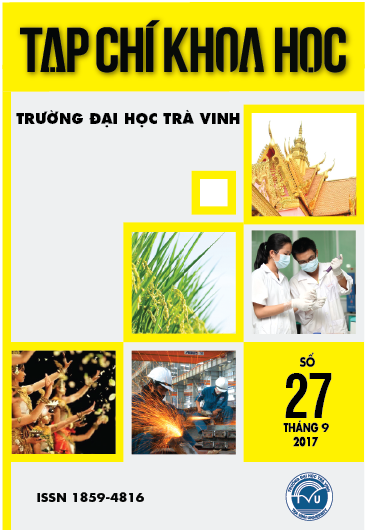INVESTIGATION ON FRUITING BODY OF CORDYCEPS MILITARIS CULTIVATION IN TRA VINH
Abstract
Cordyceps sinensis has traditionally been used in traditional Chinese medicine. However, C. sinensis has very low mass production and only grows in natural environment, whereas the fruiting bodies of Cordyceps militaris can be successfully farmed in cereals. C. militaris contains similar biochemical components as C. sinensis as well as the anticancer component cordycepin. This study is to investigate the effect of temperature, light intensity, milling of silkworm pupae supplemented with brown rice medium and silkworm pupae age on fruiting bodies of C. militaris. The optimal temperature for the formation of fruiting bodies
was 25oC, under conditions of 500 lux lighting. A bottle with 50 g of brown rice supplemented with 50 ml of distilled water and 5 g of milling silkworm pupae produced 20,11 fruiting bodies with the weight of 10.14 g, Cordycepin and Adenosine obtained were 10.08 mg/g and 0.57 mg/g, respectively. From mounting, the nine-dayold pupae showed the best incidence of infection and development of fruiting bodies of C. militaris with 1.69 fruiting bodies/pupae.
Downloads
References
Kexue Jisu Chubanshe. 1994;p. 1–323.
[2] Sung J M. The insects-born fungus of Korea in color.
Seoul: Kyohak Publishing Co. Ltd; 1996.
[3] Li S P, Yang F Q, Tsim K W K. Quality control
of Cordyceps sinensis, a valued traditional Chinese
medicine. Journal of Pharmaceutical and Biomedical
Analysis. 2006;41:1571–84.
[4] Zhang Y J, Li E, Wang C S. Ophiocordyceps
sinensis, the flagship fungus of China: terminology,
life strategy and ecology. Mycology. 2012;3:2–10.
[5] Sung J M, Choi Y S, Lee H K, Kim S H, Kim Y O,
Sung G H. Production of fruiting body using cultures
of entomopathogenic fungal species. Kor J Mycol. 1999;27:15–9.
[6] Hong I P, Kang P D, Kim K Y, Nam S H, Lee M Y,
Choi Y S, et al. Fruit body formation on silkworm by
Cordyceps militaris. Mycobiology. 2010;38(2):128–132.
[7] Lê Văn Vẻ, Trần Thu Hà, Nguyễn Thị Bích Thủy,
Ngô Xuân Nghiễn. Bước đầu nghiên cứu công nghệ
nuôi trồng nhộng trùng thảo (Cordyceps militaris L.
ex Fr.) ở Việt Nam. Tạp chí Khoa học và phát triển. 2015;13(3):445–454.
[8] Gao X H, Wu W, Qian G C. Study oninfluences of abiotic factors on fruitbody differentiation
of Cordyceps militaris. Acta Agriculture Shanghai. 2000;16:93–98.
[9] Sato H, Shimazu M. Stromata production for Cordyceps militaris (Clavicipitales: Clavicipitaceae) by injection of hyphal bodies to alternative host insects.
Applied Entomology and Zoology. 2002;37:85–92.
[10] Kim S Y, Shrestha B, Sung G H, Han S K, Sung J M. Optimum conditions for artificial fruiting body
formation of Cordyceps cardinalis. Mycobiology. 2010;38(2):133–136.









